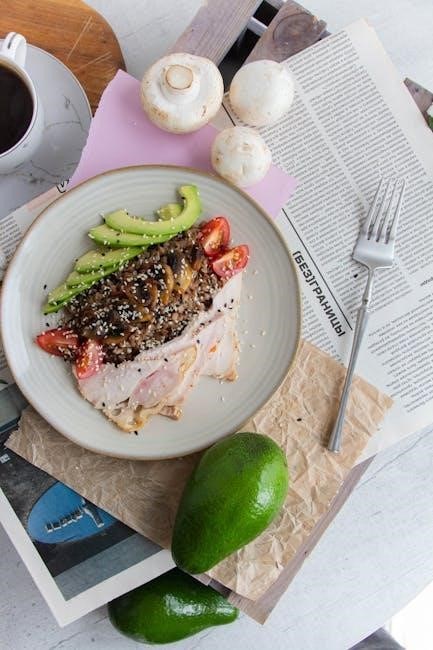
The 40-30-30 meal plan is a balanced dietary approach focusing on 40% carbohydrates, 30% protein, and 30% fats. It promotes weight loss, improved blood sugar control, and sustained energy, ideal for those seeking a structured yet flexible eating plan.
Overview of the 40-30-30 Macro Ratio
The 40-30-30 macro ratio divides daily calories into 40% carbohydrates, 30% protein, and 30% fats. This balanced approach ensures adequate energy from carbs, muscle support from protein, and essential fatty acids for overall health. The ratio is flexible, allowing customization based on individual calorie needs, making it suitable for weight loss, maintenance, or active lifestyles. By distributing macronutrients evenly, it supports metabolic balance and satisfaction, while avoiding extreme restrictions on any food group.
Importance of Balanced Nutrition in Weight Loss
Balanced nutrition is crucial for successful weight loss, as it ensures the body receives essential nutrients while maintaining metabolism and energy levels. A 40-30-30 macro ratio provides a structured approach, combining carbohydrates for energy, protein for muscle maintenance, and fats for satiety. This balance prevents extreme hunger and metabolic slowdowns, common in restrictive diets. By focusing on whole, nutrient-dense foods, the plan supports overall health and sustainable weight management, making it easier to adhere to long-term. Proper nutrition also reduces cravings and promotes a healthier relationship with food.
How the 40-30-30 Plan Differs from Other Diets
The 40-30-30 meal plan stands out by focusing on a balanced macronutrient ratio—40% carbs, 30% protein, and 30% fats—rather than restricting specific food groups. Unlike diets that emphasize cutting carbs or fats, this plan promotes a sustainable approach by balancing energy sources. It avoids extreme calorie restriction and supports muscle maintenance through adequate protein. Additionally, the plan offers flexibility, allowing customization to individual calorie needs while maintaining the macronutrient balance. This structured yet adaptable method contrasts with fad diets, providing a holistic focus on nutrition and long-term health benefits.

Understanding the 40-30-30 Macro Breakdown
The 40-30-30 plan divides calories into 40% carbs, 30% protein, and 30% fats, ensuring balanced nutrition for energy, muscle maintenance, and overall health.
40% Carbohydrates: Sources and Benefits
The 40% carbohydrate portion in the 40-30-30 meal plan emphasizes whole, unprocessed foods like whole grains, vegetables, and legumes. These sources provide sustained energy, fiber, and essential nutrients. Carbohydrates are crucial for brain function and physical activity, making them a cornerstone of this balanced approach. By focusing on complex carbs, the plan helps maintain stable blood sugar levels and supports overall health. This macronutrient ratio ensures adequate energy supply while promoting a balanced diet that aligns with weight management and long-term wellness goals.
30% Protein: Role in Weight Loss and Muscle Maintenance
The 30% protein component in the 40-30-30 meal plan is vital for muscle repair and growth, making it ideal for fitness enthusiasts and those aiming to lose weight. High-quality protein sources like lean meats, fish, eggs, and legumes help build and maintain muscle mass. Protein also boosts metabolism, enhancing fat burning, and keeps you fuller longer, reducing cravings. This balanced intake ensures muscle preservation during weight loss, promoting a leaner physique and overall health. The plan’s protein focus supports active lifestyles and long-term weight management effectively.
30% Fats: Healthy Fats for Sustained Energy
The 30% fat portion in the 40-30-30 meal plan provides sustained energy and supports overall health. Healthy fats, such as avocados, nuts, and olive oil, are essential for brain function, hormone production, and absorbing fat-soluble vitamins. They also reduce inflammation and improve heart health. Incorporating these fats helps maintain satiety, preventing overeating and cravings. This balanced fat intake ensures steady energy levels throughout the day while supporting long-term well-being. By focusing on quality fat sources, the plan promotes a sustainable and enjoyable eating approach tailored to weight loss and maintenance goals.

Benefits of the 40-30-30 Meal Plan
The 40-30-30 meal plan offers numerous benefits, including weight loss, improved blood sugar control, enhanced energy levels, and reduced hunger. It supports metabolism and overall well-being effectively.
Weight Loss and Metabolism Boost
The 40-30-30 meal plan is designed to support weight loss by maintaining a balance of macronutrients that keep metabolism active. The balanced ratio of carbs, protein, and fats ensures sustained energy levels, preventing extreme hunger and cravings. This structured approach helps the body burn calories efficiently while preserving muscle mass, which is crucial for maintaining a higher metabolic rate. By focusing on whole, nutrient-dense foods, the plan not only aids in weight loss but also promotes overall health and well-being. This makes it an effective choice for those aiming to shed pounds and improve their metabolic function.
Improved Blood Sugar Control
The 40-30-30 meal plan helps regulate blood sugar levels by balancing carbohydrate intake with protein and healthy fats. The emphasis on complex carbs, such as whole grains and vegetables, ensures a slower digestion process, preventing sudden spikes in blood sugar. This balanced macronutrient ratio stabilizes insulin levels, reducing the risk of fluctuations. By focusing on fiber-rich foods and lean protein sources, the plan supports sustained energy release, making it beneficial for individuals with diabetes or prediabetes. This approach not only improves blood sugar control but also enhances overall metabolic health, promoting a more stable and balanced dietary lifestyle.
Enhanced Energy Levels
The 40-30-30 meal plan is designed to provide sustained energy levels by balancing carbohydrates, protein, and fats. Carbohydrates offer quick energy, while protein and healthy fats support long-term endurance. This balanced macronutrient ratio helps avoid energy crashes and maintains stamina throughout the day. By focusing on complex carbs, such as whole grains and vegetables, the plan ensures a steady release of glucose, preventing blood sugar spikes. This approach not only enhances physical performance but also supports mental clarity and focus, making it ideal for active individuals and those with demanding lifestyles seeking consistent energy levels without fluctuations;
Reduced Hunger and Cravings
The 40-30-30 meal plan effectively reduces hunger and cravings by balancing macronutrients. Protein and healthy fats promote satiety, while complex carbohydrates provide steady energy, minimizing blood sugar spikes. This balanced approach helps regulate hunger hormones, keeping you fuller longer and reducing the urge for unhealthy snacks. The plan’s emphasis on whole, nutrient-dense foods also supports metabolic health, further curbing unnecessary cravings. By stabilizing energy levels and providing sustained satisfaction, the 40-30-30 plan makes it easier to adhere to your dietary goals without feeling deprived, fostering a healthier relationship with food and supporting long-term weight management.

How to Create a Personalized 40-30-30 Meal Plan
Start by calculating your daily caloric needs, then determine macronutrient ratios. Plan meals with whole foods, ensuring 40% carbs, 30% protein, and 30% fats. Adjust portions and recipes to suit preferences and goals, using meal prep for convenience and consistency. Track intake to maintain balance and make adjustments as needed for optimal results.
Calculating Daily Caloric Needs
Calculating daily caloric needs is the first step in creating a personalized 40-30-30 meal plan. This involves assessing your age, weight, height, and activity level to determine your total daily energy expenditure (TDEE). The Mifflin-St Jeor equation is a reliable method for estimating basal metabolic rate (BMR), which is then multiplied by an activity factor. Once TDEE is established, adjust the calorie intake based on your goals—whether weight loss, maintenance, or muscle gain. For example, a 1,500-calorie plan may suit weight loss, while an 1,800-calorie plan is ideal for active individuals. Regularly reassess and adjust as your needs change.
Portion Control and Meal Frequency
Portion control and meal frequency are crucial for adhering to the 40-30-30 plan. Aim for 5-6 balanced meals daily to maintain steady energy levels and metabolism. Each meal should align with the 40-30-30 macro ratio, ensuring carbs, protein, and fats are proportionally distributed. Use a food scale or measuring cups for accuracy, and adjust portion sizes based on caloric needs. Prepping meals in advance can simplify adherence and prevent overeating. Consistency in meal timing helps regulate hunger and supports weight management, making it easier to stick to the plan long-term.
Meal Prepping for Convenience
Meal prepping is a key strategy for adhering to the 40-30-30 plan, ensuring meals are ready and balanced. Set aside time weekly to prepare breakfast, lunch, and snacks, portioning them into containers. Label each meal with its macro breakdown to maintain the 40-30-30 ratio. This approach saves time, reduces food waste, and prevents impulsive unhealthy choices. Use fresh, whole ingredients and store meals in airtight containers for up to 5 days. Prepping also allows for creativity, enabling you to enjoy varied and delicious meals while staying on track with your dietary goals.

Sample 7-Day 40-30-30 Meal Plan
This plan provides a week-long structure with recipes for breakfast, lunch, and dinner, ensuring each meal aligns with the 40-30-30 macro ratio for balanced nutrition.
Breakfast Ideas and Recipes
Start your day with a Mexican omelet made from egg whites, chicken, beans, and vegetables, providing 480 calories, 33g protein, 37g carbs, and 14g fat. Another option is oatmeal with fresh fruit and nuts, balancing carbs and healthy fats. Greek yogurt with berries and chia seeds is also a great choice, offering protein and fiber. These recipes align with the 40-30-30 ratio, ensuring a balanced start to your day. Pair with a portion-controlled smoothie or avocado toast for added variety. Meal prepping these options ensures consistency and convenience throughout the week.
Lunch Options and Nutritional Information
For lunch, consider a grilled chicken breast with quinoa and steamed vegetables, totaling 500 calories, 35g protein, 45g carbs, and 15g fat. A whole-grain wrap with lean turkey, avocado, and veggies offers 450 calories, 30g protein, 40g carbs, and 20g fat. Mediterranean Chicken Salad with mixed greens, olives, and feta is another option, providing 420 calories, 25g protein, 30g carbs, and 25g fat. These meals align with the 40-30-30 ratio, ensuring balanced nutrition. Pair with a side of fruit or a small salad for added fiber and satisfaction.
Dinner Recipes and Macro Breakdown
Baked salmon with sweet potato and asparagus is a nutrient-rich dinner option. The salmon provides 35g protein, 10g fat, and 0g carbs, while sweet potato adds 25g carbs and asparagus contributes 5g fiber. A total of 400 calories, with a macro breakdown of 40% carbs, 30% protein, and 30% fat. Another option is stuffed chicken breast with quinoa and broccoli, offering 30g protein, 30g carbs, and 15g fat, totaling 450 calories. These recipes ensure balanced nutrition and align with the 40-30-30 ratio for sustained energy and weight management.
Snack Suggestions to Maintain the Ratio
Healthy snacks like mixed nuts (15g fat, 6g protein, 6g carbs) or veggies with hummus (10g carbs, 5g protein, 10g fat) fit the 40-30-30 ratio. A small apple with almond butter (15g carbs, 4g protein, 8g fat) is another great option. Hard-boiled eggs (6g protein, 1g carbs, 5g fat) provide a satisfying protein boost. Greek yogurt with berries (15g carbs, 10g protein, 0g fat) balances carbs and protein. These snacks maintain energy levels and support weight loss goals without disrupting the macro balance. They are easy to prepare and keep you on track throughout the day.

Adjusting the Plan for Different Calorie Needs
Modify portion sizes based on individual calorie goals while maintaining the 40-30-30 macro ratio to ensure personalized nutrition for weight loss, maintenance, or increased energy needs.
1200-Calorie Meal Plan for Weight Loss
A 1200-calorie meal plan is ideal for weight loss, particularly for women, offering a structured approach with breakfast, snacks, lunch, and dinner. Each meal adheres to the 40-30-30 macro ratio, ensuring balanced nutrition. Recipes include options like oatmeal with berries for breakfast, grilled chicken salads for lunch, and baked salmon for dinner. Snacks such as nuts or yogurt maintain the ratio. This plan emphasizes whole, unprocessed foods and provides nutritional breakdowns for transparency. Dairy substitutes are available for those with dietary restrictions. The 7-day plan is designed to promote steady weight loss while keeping meals flavorful and satisfying.
1500-Calorie Plan for Maintenance
The 1500-calorie meal plan is tailored for individuals aiming to maintain weight while following the 40-30-30 macro ratio. It offers a balanced mix of nutrients, with 40% from carbohydrates, 30% from protein, and 30% from fats. Meals are designed to be nutritious and satisfying, including options like whole-grain pancakes for breakfast, quinoa salads for lunch, and grilled chicken with vegetables for dinner. Snacks like Greek yogurt or mixed nuts help maintain the ratio throughout the day. This plan is flexible, allowing adjustments based on personal preferences and dietary needs, ensuring long-term sustainability and overall health.
1800-Calorie Plan for Active Individuals
The 1800-calorie meal plan is designed for active individuals requiring more energy to support their lifestyle. It adheres to the 40-30-30 macro ratio, ensuring balanced nutrition for performance and recovery. Breakfast options include high-protein meals like scrambled eggs with whole grains, while lunches feature grilled chicken or fish with complex carbs. Dinners focus on lean proteins, such as turkey or salmon, paired with fiber-rich vegetables. Snacks like nuts or fresh fruits maintain energy levels. This plan is flexible, allowing adjustments to meet specific activity demands while supporting muscle maintenance and overall health. It’s ideal for those needing sustained energy without excess calorie intake.
2100-Calorie Plan for High Energy Requirements
The 2100-calorie plan is tailored for individuals with high energy demands, such as athletes or those with physically demanding jobs. It follows the 40-30-30 macro ratio, providing ample carbohydrates for energy, protein for muscle repair, and fats for sustained performance. Meals are nutrient-dense, with breakfasts like oatmeal with nuts and berries, lunches featuring grilled chicken with quinoa, and dinners including salmon with sweet potatoes. Snacks like energy bars or Greek yogurt with honey help maintain energy levels throughout the day. This plan ensures adequate fuel for intense activities while supporting overall health and muscle recovery, making it ideal for high-energy lifestyles.

Challenges and Solutions
The 40-30-30 plan poses challenges like precise macro counting, dining out, and maintaining motivation. Solutions include using tracking apps, making informed restaurant choices, and prepping meals to stay on track.
Common Mistakes in Macro Counting
A common mistake in the 40-30-30 plan is failing to accurately track all meals, leading to imbalanced ratios. Overestimating portion sizes and neglecting added fats or condiments can disrupt the intended macros. Many individuals also miscalculate their daily caloric needs, causing frustration with progress. Additionally, relying solely on food labels without proper measurement tools, like a food scale, can result in inaccurate tracking. To avoid these errors, using a tracking app and measuring ingredients precisely is essential. Consistency and attention to detail are key to successfully maintaining the 40-30-30 ratio and achieving weight loss or health goals.
Strategies for Dining Out
When dining out on the 40-30-30 plan, focus on selecting meals with balanced macronutrients. Opt for grilled proteins like chicken or fish, pair them with complex carbs such as whole grains or vegetables, and choose healthy fats like avocado or nuts. Avoid fried or high-sugar options that disrupt the ratio. Request modifications, such as less sauce or oil, to align with your macro goals. Consider sharing meals to manage portion sizes and prevent overeating. Finally, use a food tracker app to estimate macros and stay on track, ensuring your dining experience supports your weight loss and health objectives without compromising the 40-30-30 balance.
Staying Motivated on the Plan
Staying motivated on the 40-30-30 plan requires setting clear, achievable goals and celebrating progress. Track your meals and physical changes to visualize improvements. Incorporate variety in your recipes to keep meals exciting and prevent boredom. Share your journey with a support group or friend for accountability. Reward yourself with non-food incentives like new workout gear or relaxation time. Focus on how the plan benefits your overall health, not just weight loss. Regularly reviewing success stories and reminders of your “why” can help maintain commitment and enthusiasm throughout your journey.

Downloading and Using 40-30-30 Meal Plan PDFs
Downloadable PDFs provide structured 40-30-30 meal plans with recipes, grocery lists, and nutritional insights. Customize the plans to suit your dietary needs and preferences for optimal results.
Where to Find Reliable PDF Resources
Reliable 40-30-30 meal plan PDFs can be found on reputable health and nutrition websites, fitness platforms, and dietary resources. Websites like the Texas Liver Institute and Swan Integrative Health offer detailed PDF guides. Additionally, platforms like Pinterest and official dietary websites provide customizable meal plans with recipes and grocery lists. These resources ensure you receive accurate and structured guidance tailored to your nutritional goals. Always verify the credibility of the source to guarantee high-quality, science-backed information for your 40-30-30 journey.
How to Customize the Plan for Individual Needs
To tailor the 40-30-30 meal plan, start by assessing your calorie needs, activity level, and dietary preferences. Adjust portion sizes to meet your daily calorie goals, such as 1200, 1500, or 1800 calories. Incorporate personal food preferences, swapping ingredients while maintaining the macro ratio. For example, replace chicken with plant-based proteins or substitute dairy with non-dairy alternatives. Monitor progress and adjust the plan as needed to ensure sustained energy and satisfaction. Regularly track macronutrient intake and make tweaks to keep the plan enjoyable and effective for your unique lifestyle and goals.
Printing and Organizing the Meal Plan
Download the 40-30-30 meal plan PDF and print it for easy reference. Organize the document in a binder or folder, separating sections like recipes, grocery lists, and daily schedules. Use tabs or dividers to quickly navigate between meal ideas, nutritional information, and shopping tips. Consider printing recipe cards for convenience or laminating pages for durability. Digital organization is also an option—save the PDF to a cloud storage service or use a meal planning app to access it on-the-go. This ensures your plan remains accessible and neatly arranged, helping you stay consistent with your dietary goals.
The 40-30-30 meal plan offers a balanced, flexible approach to nutrition, supporting weight loss and overall health with its structured yet adaptable macro ratio of 40% carbs, 30% protein, and 30% fats.
Final Thoughts on the 40-30-30 Diet
The 40-30-30 diet offers a balanced and sustainable approach to nutrition, emphasizing a macronutrient ratio that supports weight loss, energy levels, and overall health. By allocating 40% of calories to carbohydrates, 30% to protein, and 30% to fats, this plan fosters a harmonious intake of nutrients. It is particularly effective for those seeking to manage hunger, improve blood sugar control, and maintain muscle mass. While it may require careful planning, the flexibility of the 40-30-30 diet makes it adaptable to various lifestyles and calorie needs, ensuring long-term success for dedicated individuals.
Encouragement for Long-Term Success
Embracing the 40-30-30 meal plan is a commitment to a healthier lifestyle. Consistency is key; track your macros and celebrate small victories to stay motivated. Meal prep and planning ahead can simplify the process, ensuring you stick to your goals. Don’t be too hard on yourself during setbacks—each meal is a fresh start. Surround yourself with support, whether through online communities or friends, to maintain momentum. Remember, this plan isn’t just about weight loss; it’s about nurturing your body for long-term vitality and well-being. Stay dedicated, and the results will follow.

Additional Resources

Explore reliable PDF resources for detailed 40-30-30 meal plans, including cookbooks and online communities. Utilize macro-tracking tools and apps to monitor progress and stay consistent with your goals.
Recommended Recipes and Cookbooks
Discover a variety of delicious and balanced recipes tailored to the 40-30-30 meal plan in our curated cookbooks. Popular titles include The Zone Diet Cookbook and 40-30-30 Meal Prep Ideas, offering easy-to-follow dishes. These resources focus on clean eating, with recipes rich in whole foods, lean proteins, and healthy fats. Find inspiration for breakfast, lunch, dinner, and snacks that align with the 40-30-30 macro ratio. Many cookbooks also provide nutritional breakdowns and tips for meal prepping. Explore these resources to elevate your cooking and stay on track with your dietary goals. You can find these cookbooks in PDF format online for convenient access.
Online Communities and Support Groups
Join online communities and support groups to connect with others following the 40-30-30 meal plan. Platforms like Pinterest, Instagram, and Facebook offer vibrant groups where members share recipes, tips, and progress stories. Reddit forums and specialized dieting communities also provide valuable insights and encouragement. These spaces foster motivation, accountability, and practical advice, helping you stay consistent with your 40-30-30 journey. Engage with others, ask questions, and gain inspiration from shared experiences to ensure long-term success on your dietary path.
Tools for Tracking Macronutrients
Effectively tracking macronutrients is essential for adhering to the 40-30-30 plan. Use apps like MyFitnessPal or Lose It! to log meals and calculate macros. Online calculators and spreadsheets can also help estimate daily needs. Many 40-30-30 meal plan PDFs include macro trackers or templates for organizing meals. Additionally, barcode scanners and food databases simplify tracking packaged foods. These tools ensure accuracy and accountability, helping you maintain the 40-30-30 ratio effortlessly. They also provide insights into progress, making it easier to adjust your diet as needed for optimal results.